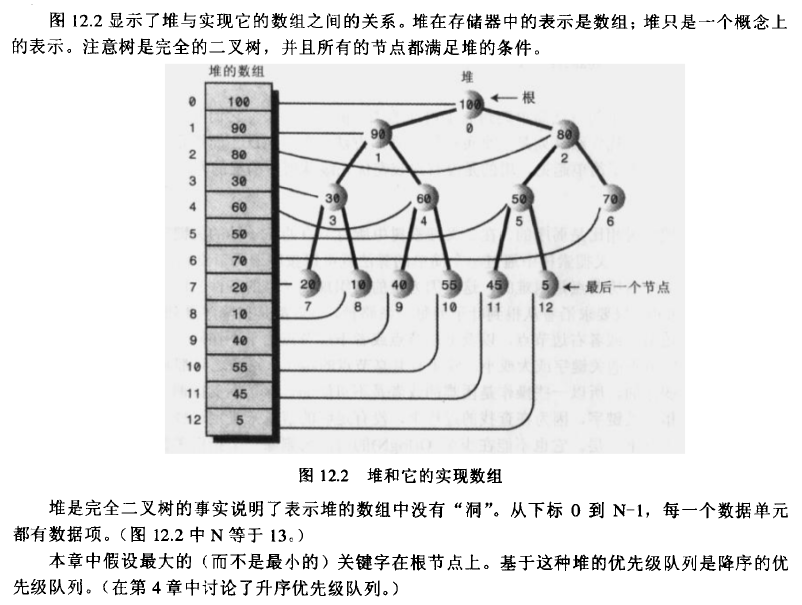



//=================================================
// File Name : Heap_demo
//------------------------------------------------------------------------------
// Author : Common
//类名:Node_Heap
//属性:
//方法:
class Node_Heap{
public int iData;
public Node_Heap(int iData) { //构造函数
super();
this.iData = iData;
}
public int getiData() {
return iData;
}
public void setiData(int iData) {
this.iData = iData;
}
}
//类名:Heap
//属性:
//方法:
class Heap{
private Node_Heap[] heapArray;
public int maxSize;
private int currentSize;
public Heap(int maxSize) { //构造函数
super();
this.maxSize = maxSize;
this.currentSize = 0;
heapArray = new Node_Heap[maxSize];
}
public boolean isEmpty(){
return currentSize ==0;
}
public boolean insert(int key){
if(currentSize == maxSize){
return false;
}
Node_Heap newNode = new Node_Heap(key);
heapArray[currentSize] = newNode; //把插入的节点放在最后的位置
trickleUp(currentSize++); //插入节点并把currentSize加1
return true;
}
//用于插入,把父类节点下移,然后把插入的节点放到合适的位置
public void trickleUp(int index){
int parent = (index-1)/2;
Node_Heap bottom = heapArray[index]; //暂存新插入的节点,因为需要把父节点下移
while(index>0 && heapArray[parent].getiData()<bottom.getiData()){ //如果小,就下移
heapArray[index] = heapArray[parent]; //把父类节点下移
index = parent; //用于递归
parent = (parent-1)/2;
}
heapArray[index] = bottom; //把插入的节点放到合适的位置
}
public Node_Heap remove(){ //删除最大的节点
Node_Heap root = heapArray[0];
heapArray[0]=heapArray[--currentSize];
trickleDown(0);
return root;
}
//用于删除,把子类节点上移
public void trickleDown(int index){
int largerChild;
Node_Heap top = heapArray[index]; //
while(index<currentSize/2){ //如果小,就下移
int leftChild = 2*index+1;
int rightChild = leftChild+1;
if(rightChild<currentSize && heapArray[leftChild].getiData() < heapArray[rightChild].getiData())
largerChild = rightChild;
else
largerChild = leftChild;
if(top.getiData()>=heapArray[largerChild].getiData())
break;
heapArray[index] = heapArray[largerChild];
index = largerChild;
}
heapArray[index] = top;
}
public void displayHeap(){
System.out.print("heapArray:");
for(int i=0;i<heapArray.length;i++){
if(heapArray[i] != null)
System.out.print(heapArray[i].getiData()+" ");
else
System.out.print(" -- ");
}
System.out.println();
int nBlanks = 32; //定义空格
int itemsPerRow = 1;
int column = 0;
int j=0; //标记当前的数组下标,从0开始
System.out.println("......................................................");
while(currentSize > 0){
if(column == 0){
for(int i=0;i<nBlanks;i++){
System.out.print(" ");
}
}
System.out.print(heapArray[j].getiData());
if(++j == currentSize){
break;
}
if(++column==itemsPerRow){ //如果每一行计数等于这一行的上限,则换行
nBlanks /= 2; //空格数减半
itemsPerRow *= 2; //每一行的上限
column = 0;
System.out.println();
}else{
for(int i=0;i<nBlanks*2-2;i++){
System.out.print(" ");
}
}
}
System.out.println("
"+"......................................................");
}
}
//主类
//Function : Heap_demo
public class Heap_demo {
public static void main(String[] args) {
// TODO 自动生成的方法存根
int anArrays[]={1,2,3,4,5,6,7,8,9,10};
Heap theHeap = new Heap(31);
// theHeap.insert(1);
// theHeap.insert(2);
// theHeap.insert(3);
// theHeap.insert(4);
// theHeap.insert(5);
// theHeap.insert(6);
for(int i=0;i<10;i++){
theHeap.insert(anArrays[i]);
}
theHeap.displayHeap();
//theHeap.remove();
//theHeap.displayHeap();
for(int i=0;i<10;i++){
anArrays[i]=theHeap.remove().iData;
}
for(int i=0;i<10;i++){
System.out.print(anArrays[i]+" ");
}
}
}
